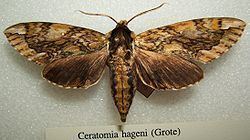Kingdom Animalia Class Insecta Family Sphingidae Scientific name Ceratomia hageni | Phylum Arthropoda Order Lepidoptera Genus Ceratomia Rank Species | |
 | ||
Similar Paratrea plebeja, Ceratomia, Sphinx franckii, Ceratomia amyntor, Manduca jasminearum | ||
Hagen's Sphinx (Ceratomia hageni), sometimes referred to as the Osage Orange Sphinx, is a hawk moth of the Sphingidae family.
Contents
Range
Ceratomia hageni is a native of midwest North America and can be found from Michigan to Georgia, Nebraska to Texas, and most places in between, with regards to its only known host plant.
Life cycle
From oviposition of the eggs to pupation, approximately four weeks will pass. Where multiple broods occur, pupae will eclose in two weeks, or when conditions are suitable in cool climates. Adult C. hageni have many colors, viewable when looked over thoroughly. The forewing(FW) is grayish green and has many, wavy lines, similar to other specimens of the Ceratomia genera. The hindwing(HW) is a browner gray with a lighter gray towards the outer margins.
Egg
Translucent, milky-white, green eggs are oval, being about .5 mm in diameter. Eggs are laid in masses on the undersurface of leaves, while smaller masses are deposited onto branches on the Osage-orange tree. Eggs incubate and hatch five to seven days after oviposition.
Pupa
As with most other Sphingidae, Ceratomia hageni will burrow into the ground after its fifth and final instar in order to pupate. The larvae will go into a "wandering" stage where it leaves the Osage-orange tree and climbs to the ground to find a place to bury itself so that it may pupate. The larvae will then shed its fifth instar skin to reveal its pupal skin, which will be soft and almost translucent at first, but will then harden to a light brown for protection from the elements.
Food Plants
C. hageni is known to feed on only one food;
